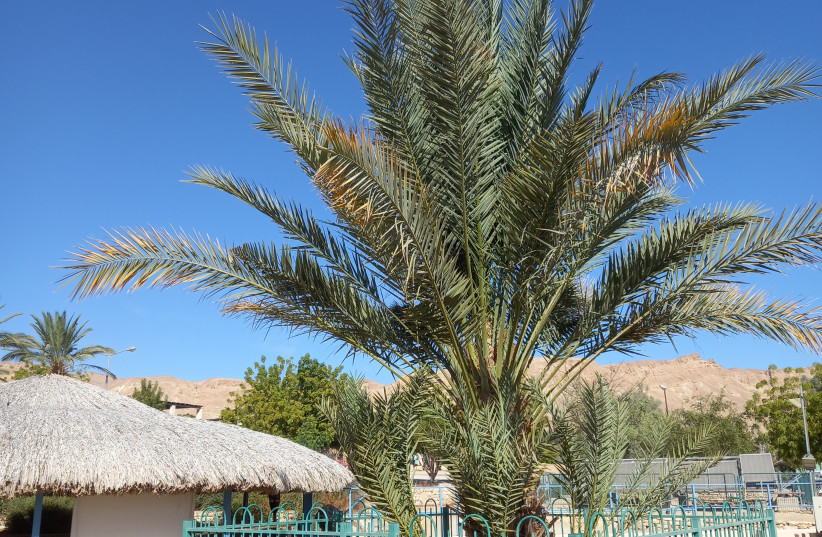This lovely illustrated book The Miracle Seed for ages eight to 14 tells the story of an ancient Judean date palm seed, germinated at the ripe old age of roughly 2,000 years and grown into a healthy tree.
This miraculous act of midwifery was realized through the meticulous collaboration of two Israeli scientists: Dr. Sarah Sallon, director of Hadassah Medical Organization’s Natural Medicine Research Center; and Dr. Elaine Solowey, a plant researcher at the Center for Sustainable Agriculture at the Arava Institute for Environmental Studies.
The tree – named Methuselah after the longest-lived person in the Bible – and subsequent date palms grown by Solowey from other ancient seeds found in Israel have been the subject of many articles over the past 12 years.
Using engaging illustrations and language, Martin Lemelman makes this wonderful true story accessible to younger readers.
He first goes back in history to help the reader conceptualize the context in which the seeds were lost and found.

The story of the seeds
This chronology begins with the Jewish rebellion against Rome, which led the brutal emperor Titus to order the destruction of “everything precious to the Jews,” including, famously, the Second Temple, but also Judean date palm trees.
“The soldiers knew this palm was no ordinary palm... it was a treasure in Israel and prized throughout the ancient world. It bore the sweetest fruit... and was also believed to cure many diseases including toothache, malaria – even cancer,” he explains.
“The soldiers knew this palm was no ordinary palm... it was a treasure in Israel and prized throughout the ancient world. It bore the sweetest fruit... and was also believed to cure many diseases including toothache, malaria – even cancer.”
Martin Lemelman
Lemelman even includes an illustration of the famed “Judea Capta” Roman coin depicting a weeping woman symbolizing the conquered people, and a Judean date palm symbolizing the conquered land.
Crusades and neglect, among other possible factors, wiped out any remaining date palms in the Holy Land. But in 1963, archaeologists unearthed a clay jar of date palm seeds hidden away by the legendary martyrs of Masada. Later, additional old seeds were found in other parts of the Judean desert, including in an ancient burial cave near Jericho.
In 2004, Sallon got permission to take some of the seeds – she was interested in their possible medicinal value – and recruited Solowey to try germinating them. They were planted on January 25, 2005, and Methuselah’s first flowers bloomed in 2011.
“The pollen from its flowers has been shared with scientists in Saudi Arabia and the United Arab Emirates,” Lemelman writes. “It’s been crossbred with modern species of date palms to produce stronger trees and sweeter dates.”
Solowey was the author’s source for all information related to the plant science of this amazing project. Sallon, who chose not to contribute to Lemelman’s book, told this reviewer that she has written her own account of the Methuselah story – as well as the later germination of six more ancient date seeds – and is currently looking for a suitable children’s publisher.
As Lemelman relates, each seedling received a biblical name that sometimes had to be changed after Solowey determined the gender of the tree because date trees are either male or female. Thus, Eve became Adam, Judah became Judith, Jeremiah became Hannah.
One cute nugget missing from his account: Sallon named two plants that germinated around Shavuot time “Ruth” and “Boaz” because the Book of Ruth is read on Shavuot. When genetic analysis revealed that Ruth was male, Sallon changed the name to Uriel, after her own son. I mention this not as a criticism of Lemelman’s accurate and thorough reporting but to highlight just how personal and precious the project has been for both women.
In his book, Lemelman beautifully conveys the excitement of Hannah’s first harvest of 111 dates, pollinated by Methuselah, following 15 years of Solowey’s hard work.
Speaking of hard work, the author shares, in a graphic afterword, that it took him two years to produce the book, providing a rare and interesting window into the creative process.
To top it all off, he adds a helpful time line of key events in the history of the Land of Israel from the building of the First Temple to the present day, when “Hannah continues to thrive and produce fruit, and research continues on the Judean date palm and how it might be used to treat diseases.”
The Miracle Seed is a highly recommended book for children, parents and grandparents, who will be entertained and educated by this delightful story of renewal against all odds. It’s a very different and refreshing look at Israeli ingenuity, science and connection to the indigenous flora of the homeland.
The Miracle Seed
By Martin Lemelman
Eerdmans Books for Young Readers
80 pages, $18.99
